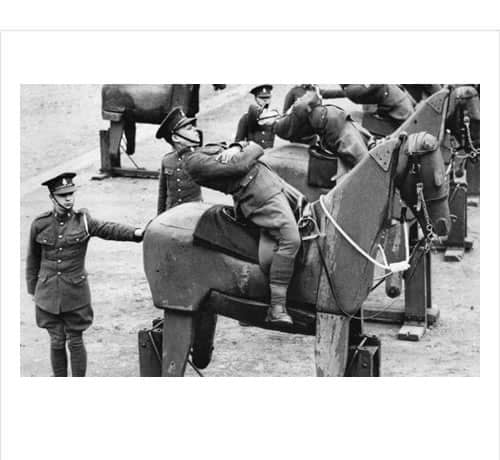In the 1930s the association with horses produced a type of individual who considered himself a cut above the foot sloggers and could be found in all Regiments where stables formed part of the daily routine.
Men enlisted in the Cavalry of the Line and were posted to Regiments. The 7th Hussars in the mid-’30s was stationed at Hounslow; living accommodation was above the stables, thus ensuring that troops were always available for the everlasting needs of the horse. With the closing down of the Cavalry Depot, Canterbury, recruits trained with their Regiments.
The training was hard and covered square bashing, musketry, riding school and the ever-present spit and polish.
The trained Cavalryman was always fully equipped; everyday horses had to be exercised, watered, fed, mucked out, groomed, plus saddlery and accoutrements cleaned and polished.
Mounted parades, mounted skill at arms, and manoeuvres were all part of his role, and his life was always bounded by the horse and its needs.
The food was good but basic (you only had one choice). There was the daily rush to meals to ensure a seat near the head of the table where two old sweats collected the food and dished it out.
Walking out was in uniform unless you had a civilian clothes pass (after 18 months of service), Hounslow sported many public houses to the delight of a soldier who was invariable without money by midweek, however, if he was the proud possessor of one shilling, his evening night out was assured.
Pint of beer: 4 pence
10 cigarettes: 4 pence
1 hot pie: 4 pence
Old money, 12 pence = 1 shilling.
The U.K. tour for the 7th Hussars was nearing its end and they duly left for Egypt by troopship in 1935 (we would not return to England for over 12 years). The voyage was uneventful except for the sleeping arrangements which were hammocks. These had to be taken down each morning and stowed away so that the space left could be used for messing and leisure.
Arrival in Egypt heralded a different way of life through the needs of the horse were the same. Training invariably finished at midday, leaving afternoons for outdoor sports and other activities. Social life was limited, there was a leave camp near Alexandria, and troops pursued hobbies in barracks. Walking out was in uniform and Cairo offered a nightlife that was always an attraction.
With the rise of Fascism and the threat of war, in 1936 the last mounted parade took place and mechanisation overtook the 7th Hussars and was completed in 1937.
Many of our horses would be sold off or transferred to other units, but the surplus would be shot and sold to the locals as meat.
For the Cavalryman and his horse, this was the end of an era of nearly 300 years as a mounted Regiment.
Major ASC Blackshaw MBE Quartermaster 1935-1970


